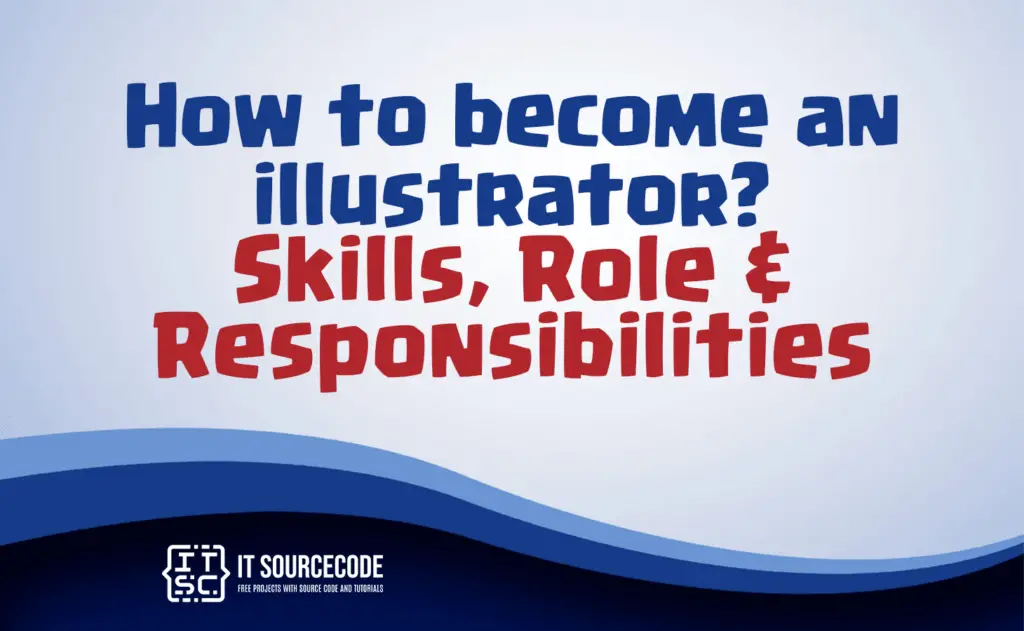HOW TO BECOME AN ILLUSTRATOR? | SKILLS, ROLE & RESPONSIBILITIES – Illustration is a vital tool in visual storytelling, spanning various mediums like magazines, children’s books, and comics.
Starting a career as an Illustrator involves education, niche selection, skill development, and portfolio building.

What is an Illustrator?
Illustration plays a crucial role in visual storytelling, offering diverse styles suitable for magazines, children’s books, and comics. In the past, illustrators used analog tools like pencils and paints, relying on lithographers to prepare their work for publication.
However, as lithographers became scarce, modern illustrators have embraced digital methods, scanning or photographing their art for printing.
Traditional approaches, such as original drawings and lithography, are still acceptable, depending on client preferences. Familiarity with computer programs is essential for meeting contemporary expectations in the field of illustration.
Illustrator VS Graphic Designer
Illustrators and Graphic Designers share the goal of visual communication, but their roles and focus vary. While Illustrators create visual representations of written content and concepts, Graphic Designers aim to convey targeted messages through marketing assets, logos, and sales materials.
While both professions have similarities, Graphic Designers’ work directly impacts business success, while Illustrators primarily focus on storytelling and artistic expression.
How to become Illustrator
Embarking on a career as an Illustrator requires careful planning and preparation.
The process can be broken down into four essential stages: acquiring education in fine arts or specialized illustration programs, choosing a particular area of focus, honing skills and utilizing appropriate tools, and creating a captivating portfolio to showcase artistic abilities.
Establishing a strong personal brand through networking, job applications, and active social media presence is crucial for gaining recognition and maximizing opportunities in the competitive field of illustration.
What are the Important Skills of an Illustrator?
Illustrators collaborate with diverse clients, such as authors, editors, and graphic designers, necessitating a broad skill set for success.
An excellent Illustrator should possess the following qualities:
- Exceptional negotiation skills
- Proficient in designing, sketching, and portrait techniques
- Solid photographic abilities
- Knowledgeable in IT and design applications
- Creative and innovative with a keen eye for color, proportion, and composition
- Ability to effectively convey ideas and concepts through drawings
- Talented in producing clean, crisp, and aesthetically pleasing designs.
Role and Responsibilities of Illustrator
- Generate preliminary drafts following given guidelines
- Refine designs using illustration software
- Incorporate diverse colors, visuals, and effects to enhance each illustration
- Apply computer-aided design (CAD) software for photo formatting
- Employ isometric techniques to add perspective to complex objects
- Set and manage time and budget constraints
- Ensure printed illustrations meet quality and color standards
- Collaborate with the design team to develop new concepts and styles
- Stay updated on the latest design trends and software
- Create comprehensive illustrations by blending hand-drawing and digital media
- Engage in design briefs with clients, editors, or marketers to understand their requirements.
Types of Job of Illustrator
Illustration jobs can be categorized into traditional in-house positions and freelance work. Traditional illustration jobs involve creating illustrations for a single employer on an ongoing basis, often full- or part-time.
Examples include drawing storyboards for a publishing company or creating artwork for a video game developer.
On the other hand, freelance illustrators work for multiple clients on short-term projects, providing them with more flexibility in choosing whom to work with and what kind of projects to take on.
Freelance work may lack the stability of traditional employment, but it offers greater freedom and variety in projects.
Expected Salary of Illustrator
In the United States, the income of illustrators varies widely, with the majority earning between $33,500 and $42,999 annually. Some may earn as much as $128,500, while others may receive only $24,000 per year. The earnings depend on the type of illustration work and the local job market.
Additional Resources
- Slack vs. Trello | Choose the Right Collaboration Tool
- What Is A Responsive Website?
- System Design Interview Preparation
Conclusion
An illustration is a dynamic and essential aspect of visual storytelling, offering diverse styles for various mediums. From traditional to digital methods, illustrators have embraced new techniques while still valuing client preferences. To embark on an illustrator’s journey, one needs a blend of education, specialization, honed skills, and an impressive portfolio.
Personal branding and networking play pivotal roles in gaining visibility and seizing opportunities in this competitive field. The income for illustrators can vary significantly, impacted by their specialization and local job markets. Overall, illustration presents a rewarding career path for those passionate about visual expression and storytelling.

